Known as the “Crescent,” the 95,000-sq.-ft. addition to Boston International Airport’s Terminal E—which serves all international arrivals and most international departures—adds three new gates, each with two parallel jetways to accommodate boarding at both levels of an A380 aircraft, or front and rear exits of other aircraft. Without these larger boarding gates, the economic viability of accepting A380 aircraft would not work. The A380 is the largest commercial aircraft in the world, which can carry almost 550 people on mixed class flights and more than 850 people in single-class configurations.
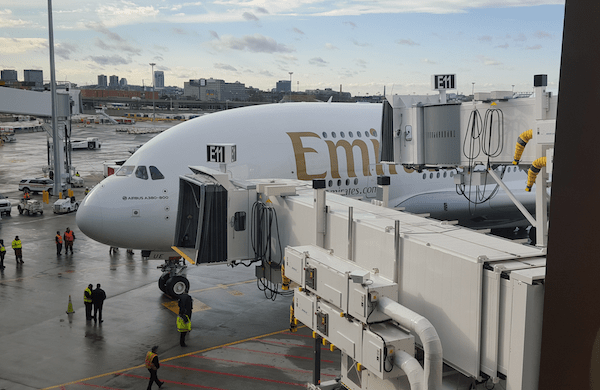
The project steel topping-off was in April 2016 and the building received its first A380 aircraft—pictured, Emirates Airlines—in January 2017.
There is a secure arrivals corridor on Level 2, to conduct arriving passengers to Passport Control. On Level 4, there are premium club spaces for British Air, Emirates and Lufthansa clubs. The remaining 35,000 sq. ft. is a departures hold room with associated toilet facilities, which is open to the original 1974 Terminal E hold-room.

The solar add-on was incorporated into the project during construction. Site is ideal with a solid south-facing roofscape directly above these stacked mechanical rooms. The stainless steel cabinet to the left is for electric heat trace control for exposed plumbing piping below the floor.
The primary means of generating domestic hot water at Logan, and many other airports, are commercial electric resistance heaters, says Brad White, mechanical discipline lead for Arora Engineers Inc.’s Boston office, serving the New England region. “These are typically chosen because the Massachusetts Port Authority has a low negotiated electrical rate and the life-cycle cost of such heaters is economically supportable,” says White.
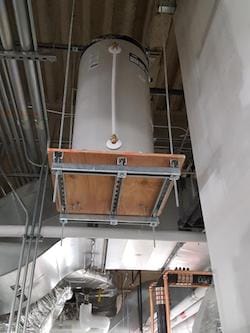
Solar drain-back tank (not yet piped in this photo). All fluid drains back to a point about 2/3 the way up the tank, when system is at rest. No glycol is used, just clear water pumped up and drained back.
The addition of solar to the mix, says White, was born of a desire to augment Logan Airport’s commitment to a wide variety of off-grid enhancements. For example, its parking garages have been a test bed for solar PVAs and wind turbines to shave off peak loads and support local uses. “The solar component was budgeted relatively late into the project’s construction schedule and the bulletin was released about the time the base domestic hot water system was being piped up. We had advanced certain valves, tees and bypasses to make-ready to receive the solar thermal contribution,” says White.

HTP solar HW tank at right; base Bradford White EWH-1 at left. Taco recirculation pumps in between. The right pump is for blending and unifying both tanks so the solar tank becomes additional storage when solar is not viable. Otherwise, that pump is off.
Located on Level 3, the mechanical room features a 119-gallon HTP solar tank, which is used as a pre-heating tank, and all cold water entering the system is diverted through the solar tank to be preheated. A collector sensor and a Caleffi differential temperature controller operate the collector side pump. Because this is a drain-back system, there is no need for a dump zone. When the solar tank cannot keep up, a Bradford White—no relation—base electric hot water heater elements finish the water to temperature. The DHW system operates to maintain 150 degrees F for Legionella control, then mixes down to 115-120F for distribution. Mixed output of DHW is on a recirculation loop, necessary to keep water available at metered faucets without wait. Local integral mixing valves at each lavatory complete the temperature control.
Three roof-mounted Apricus vacuum tube panels see approximately 6 gpm of clear water circulation via an HTP drain-down tank, located on Level 4. It is a closed system. No potable water comes in contact with the solar-side of the system. By Massachusetts’ state plumbing code, the heat exchanger is double-wall vented to avoid cross-connection. “With the reduced load, we expect that the solar contribution will satisfy peak demands on most sunny days and overall load absorption will be in the order of 65%,” says White.
The project is tracking LEED Gold, with toilet rooms that feature Toto metered faucets and low-flow urinals and water closets. Overall, the water flow consumption will be 48% better than—lower than—code for the passenger core functions. The food concession space reduces this to a still-respectable 37+ percent better than code.
- Plumbing contractor — P.J. Dionne Plumbing and Heating, of Wilmington, Mass.; Tom Kosik, foreman.
- Arora Engineers Inc. is a 150-person multi-discipline engineering firm based in Chadds Ford, Pa., with offices in Boston, Newark, Philadelphia, Baltimore, Charlotte, Atlanda, Fort Lauderdale and San Jose, with a focus on transportation infrastructure.
- At peak, four plumbers on-site, but typically two on most days.
NOTE: White says that his punchlist work is not done, notably to specify extended handles on the valves to clear the insulation.

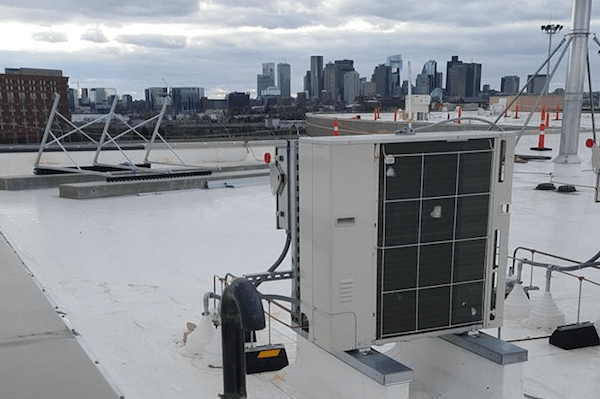
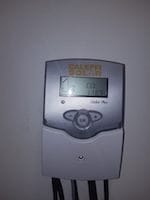

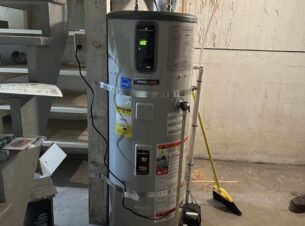

Join the conversation: